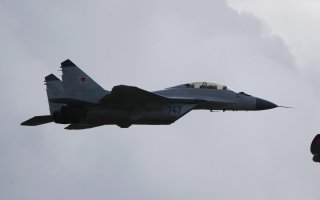Russia's MiG-35: Just How Good Is This 4th Gen Fighter?
While the MiG-35 is certainly one of the more capable fourth-generation plus platforms that exists, it has struggled to enter markets outside of Russia.
Here's What You Need to Know: Despite its acrobatic capabilities, there is a long road ahead for the MiG-35.
The MiG-35 is Russian Aircraft Corporation’s (formerly known as Mikoyan and Gurevich Design Bureau) most up-to-date fourth-generation fighter that fits in the 4++ range — that is, fourth-gen aircraft that are updated with the newest in materials, engines, avionics, and some reduced radar cross-section capabilities.
4++ Generation Airplanes
The MiG-35 is the essence of the latest member of the MiG-29 family of twin-engine fighters. It is based on the Mig-29K, which is an update of the MiG-29M, itself an update of the 1970’s era MiG-29 air superiority fighter.
According to the MiG website, their 4++, or fourth-generation advanced fighters are “a new unified family of multi-role fighters…[that] have a high level of structure, power plant, airborne systems, avionics and weapons unification.”
The 4th generation plus fighters are to fill a variety of missions and take on several roles, including “air-defense missions of naval forces, air superiority gaining, sea & ground targets destruction with the high precision-guided weapons day and night and in any weather conditions.”
4++ generation aircraft essentially try to squeeze a much performance out of 4th generation airframe blueprints as possible, by using improved, more aerodynamically effective designs, lighter-weight composite materials, increased weapons load and weapon range, higher fuel efficiency, and reduced radar signatures through the use of radar-absorbent materials and/or paint.
Classic MiG, Redesigned
One of the big draws for MiG is the MiG-35 platform’s thrust vectoring capability. In all airplanes, air enters an engine intake, is mixed with fuel, compressed, and ignited, creating thrust. Spent hot air and exhaust gasses are then dispelled from the rear of the engine.
Aircraft with a thrust vectoring capability have greater control over the direction their exhaust takes, and are therefore more maneuverable. Rather than simply shooting backward out of the rear of the engine, exhaust can be directed, sometimes in multiple directions simultaneously, by adjustable nozzles, allowing the aircraft to execute much sharper maneuvers than would otherwise be possible using traditional control surfaces.
This particular MiG was apparently intended to carry laser weapons, although that is probably hearsay and unlikely to happen.
No Deal
While the MiG-35 is certainly a capable platform, and considering its advanced thrust vectoring capabilities, perhaps one of the more capable fourth-generation plus platforms that exists, it has struggled to enter markets outside of Russia.
Egypt had expressed some interest in acquiring the MiG-35, but evidently opted for the presumably cheaper MiG-29M, itself quite similar to the MiG-35.
Indeed, even within the Russian armed forces, the MiG-35 casts a particularly small shadow. Online sources indicate that only 2 serial production fighters are in Russian inventories.
Despite its acrobatic capabilities, there is a long road ahead for the MiG-35.
Caleb Larson is a Defense Writer with The National Interest. He holds a Master of Public Policy and covers U.S. and Russian security, European defense issues, and German politics and culture.
This article first appeared earlier this year and is reprinted due to reader itnerest.
Image: Reuters

